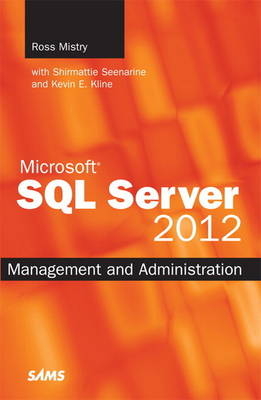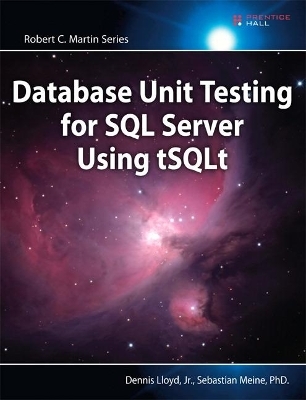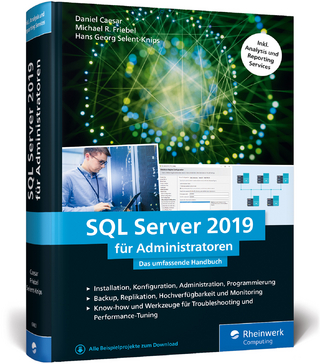
Microsoft SQL Server 2012 Management and Administration
Sams Publishing (Verlag)
978-0-672-33600-3 (ISBN)
- Titel ist leider vergriffen;
keine Neuauflage - Artikel merken
As someone who helped influence the design of SQL Server 2012 and drawing on many months of beta testing, Ross Mistry provides immediately usable solutions for installation and upgrades, management and monitoring, performance and availability, security, consolidation, virtualization, troubleshooting, and more. Mistry identifies new features and corresponding best practices in every chapter, helping you take full advantage of new SQL Server innovations ranging from private cloud support to AlwaysOn Availability Groups.
Understand how to:
Efficiently install or upgrade the SQL Server 2012 database engine
Administer and configure database engine settings, storage, I/O, and partitioning
Transfer data on-premise or to the cloud
Manage and optimize indexes
Learn how to consolidate, virtualize and optimize SQL Server for Private Clouds
Harden and audit SQL Server 2012 environments
Administer security and authorization, including new Contained Databases
Encrypt data and communications
Design and deploy new AlwaysOn high-availability and disaster recovery features
Implement maintenance best practices, including Policy-Based Management
Ross Mistry is an author, public speaker, principal enterprise architect, and veteran in the Silicon Valley. He has published numerous books and articles and frequently speaks at conferences worldwide. With more than 15 years of experience, Ross has been a trusted advisor providing strategic guidance for many C-level executives and has been responsible for planning and implementing technology solutions for some of the largest companies in the world. He has taken on the lead architect role for many Silicon Valley internet startups and Fortune 100 organizations, including Network Appliance, McAfee, The Sharper Image, Visa, CIBC, Levi’s, Wells Fargo, and Intel. He specializes in data platform, business productivity, unified communications, core infrastructure, and private cloud. At Microsoft, Ross is a director and principal enterprise architect at the Microsoft Technology Centers (MTCs). The MTCs are collaborative environments that provide access to innovative technologies and world-class expertise, giving organizations the ability to envision, design, and deploy solutions to meet their exact needs. He is currently in the process of launching and leading the first MTC in Canada. Ross is an active participant in the SQL Server community. He comanaged the main Microsoft SQL Server Twitter account @SQLServer and frequently speaks at technology conferences around the world. He has recently spoken at TechEd, PASS Summit, SQL Connections, and SQL BITS. He is a series author and has formulated many best practices and written many whitepapers and articles for Microsoft, SQL Server Magazine, and Techtarget.com.
Introduction 1
Part I: SQL Server 2012 Database Engine Administration and Management Topics
1 Installing or Upgrading the Database Engine to SQL Server 2012 13
What’s New for Installation with SQL Server 2012? 14
Preplanning and Preparing a SQL Server 2012 Server Database Engine Installation 16
Gathering Additional Information Necessary to Proceed 25
Installing a New Installation of SQL Server 2012 31
Upgrading the Database Engine to SQL Server 2012 40
Finalizing the SQL Server 2012 Installation or Upgrade 51
Installing SQL Server 2012 on Windows Server Core 53
Managing SQL Server 2012 Installations 62
Summary 64
Best Practices 64
2 Administering and Configuring the Database Engine Settings 67
What’s New for DBAs When Administering the Database Engine on SQL Server 2012 68
Administering SQL Server 2012 Server Properties 68
Administering the SQL Server Database Engine Folders 87
Administering Database Properties 98
SQL Server Database Engine Management Tasks 114
Administering the SQL Server Agent. 119
Summary 123
Best Practices 124
3 Administering Storage, I/O, and Partitioning 127
What’s New for DBAs When Administering Storage on SQL Server 2012 128
Storage Hardware Overview 129
Designing and Administering Storage on SQL Server 2012 140
Designing for BLOB Storage 158
Designing and Administrating Partitions in SQL Server 2012 164
Data Compression in SQL Server 2012 172
Summary 175
Best Practices 175
4 Creating Packages and Transferring Data On-Premise and to the Cloud. 179
What’s New in Integration Services for SQL Server 2012. 180
Options for Creating Packages 181
Integration Services Packages 182
Developing Packages 189
Enhancing Packages 199
Deploying and Running IntegrationServices Packages 212
Transferring Data with Integration Services 221
Moving Data to the Cloud 224
Summary 228
Best Practices 228
5 Managing and Optimizing SQL Server 2012 Indexes 229
What’s New for Indexes with SQL Server 2012 229
The Importance of Indexes 230
How Indexes Work 230
General Index Characteristics 238
Index Design and Strategy 242
Administering Indexes 247
Configuring Indexes for Maximum Performance 268
Summary 280
Best Practices 280
6 Backing Up and Restoring SQL Server 2012 Databases 283
What’s New for Backup and Recovery with SQL Server 2012? 283
The Importance of Backups 285
Backing Up and Recovering the Database Engine 289
Backup and Recovery Impact on Other Database Engine Features 324
Summary 330
Best Practices 330
Part II: Hardening, Auditing, and Securing SQL Server 2012
7 Hardening and Auditing a SQL Server 2012 Implementation 335
What’s New for Hardening and Auditing SQL Server 2012 Implementation? 336
Windows and SQL Server Authentication 337
Using Configuration Tools to Harden the Installation 343
Hardening SQL Server Service Accounts 350
Installing Service Packs and Critical Fixes 355
Leveraging SQL Server Auditing Strategies 357
Monitoring Events with SQL Server Audit 359
Additional SQL Server Hardening Recommendations 373
Summary 379
Best Practices 380
8 Administering SQL Server 2012 Security and Authorization 383
What’s New for Security and Authorization with SQL Server 2012? 383
SQL Server Security 385
Security Management DDL 398
Administering SQL Server Security 404
Contained Database Authentication 421
Summary 427
Best Practices 427
9 Encrypting SQL Server 2012 Data and Communications 429
What’s New for Encryption with SQL Server 2012? 430
Encryption in SQL 431
Column Encryption 432
Securing the Data Storage 435
Extensible Key Management 444
Transparent Data Encryption 446
Securing Connections 452
Using Certificates 456
SQL Server and BitLocker Drive Encryption 465
Configuring BitLocker Drive Encryption on a SQL Server System 469
Summary 478
Best Practices 478
Part III: SQL Server 2012 AlwaysOn High-Availability and Disaster Recovery Alternatives
10 Implementing and Managing AlwaysOn Availability Groups 483
SQL Server 2012 AlwaysOn Availability Groups Overview 484
Implementing AlwaysOn Availability Groups 490
Managing AlwaysOn Availability Groups 509
Monitoring and Troubleshooting AlwaysOn Availability Groups 520
Summary 525
Best Practices 526
11 Implementing and Managing AlwaysOn Failover Cluster Instances 527
SQL Server 2012 AlwaysOn Failover Cluster Instances Overview 527
What’s New for SQL Server 2012 AlwaysOn Failover Cluster Instances? 528
Additional Elements of AlwaysOn Failover Cluster Instances 537
Implementing a Single-Instance SQL Server 2012 Failover Cluster. 544
Implementing a Multiple-Instance SQL Server 2012 Failover Cluster 564
Multi-subnet SQL Server 2012 Failover Cluster Overview 568
Implementing Multi-subnet SQL Server 2012 Failover Cluster 571
Managing Failover Clusters from a SQL Server 2012 Perspective 574
Verifying the Status of Clustered Service and Applications, Nodes, Storage, and Networks 574
Managing Failover Clusters from a Windows Server 2008 R2 Perspective 580
Summary 583
Best Practices 583
12 Implementing and Managing Database Mirroring 587
SQL Server 2012 Database Mirroring Overview 588
Combining Database Mirroring with Other SQL Server 2012 Technologies 596
Implementing a Database Mirroring Session 599
Managing a Database Mirroring Session 607
Monitoring and Troubleshooting a Database Mirroring Session 614
Summary 618
Best Practices 619
13 Implementing and Managing Replication 621
SQL Server 2012 Replication Essentials 622
Implementing SQL Server Replication 639
Managing SQL Server 2012 Replication 667
Monitoring and Troubleshooting SQL Server Replication 670
Summary 672
Best Practices 672
Part IV: Performance Tuning, Monitoring, Troubleshooting, and Maintenance
14 Performance Tuning and Troubleshooting SQL Server 2012 677
Platform Troubleshooting and Optimization 680
Database Troubleshooting and Optimization 691
Application Optimization and Troubleshooting 714
Introducing Extended Events to Troubleshoot SQL Server 718
Summary 726
Best Practices 726
15 Monitoring SQL Server 2012. 729
What’s New for Monitoring in SQL Server 2012? 730
Gaining Quick Insight into a SQL Server System 731
The Data Collector and the Management Data Warehouse 744
SQL Server Utilities 757
Creating Operators and Sending Email Alerts 763
Using the Windows Server 2008 R2 Performance
Monitoring Tools 769
Additional Tools to Monitor SQL Server 2012 776
Summary 777
Best Practices 777
16 SQL Server 2012 Maintenance Practices 779
What’s New for Maintenance with SQL Server 2012? 779
Establishing a SQL Server Maintenance Plan 780
Creating a Maintenance Plan 792
Establishing Maintenance Schedules for SQL Server 805
Summary 807
Best Practices 807
Part V: Multi-Instance Management, Consolidation, and Private Clouds
17 Implementing and Managing Policy-Based Management 811
Introduction to Policy-Based Management 811
Policy-Based Management Concepts 813
Implementing Policy-Based Management 819
Monitoring and Enforcing Best Practices by Using Policy-Based Management 830
Summary 836
Best Practices 836
18 Managing Workloads with Resource Governor 839
What’s New for Resource Governor in SQL Server 2012 840
Overview of Resource Governor Concepts, Workflow, and Scenarios 841
Implementing and Configuring Resource Governor 845
Creating a Workload Group 852
Understanding Default Transact-SQL Syntax with Resource Governor 858
Managing Resource Governor 860
Monitoring Resource Governor 862
Summary 867
Best Practices 868
19 Consolidation, Virtualization, and Private Clouds 869
Understanding Consolidation, Virtualization, and Private Cloud Strategies 870
Planning Your Implementation of Hyper-V 878
Installation of the Microsoft Hyper-V Server Role 883
Becoming Familiar with the Hyper-V Administrative Console 886
Installing a SQL Server 2012 Guest Operating System Session 889
Modifying SQL Server 2012 Guest Session Configuration Settings 893
Launching a Hyper-V Guest Session 898
Using Snapshots of Guest Operating System Sessions 900
Optimizing SQL Server 2012 for Private Cloud 903
Summary 905
Best Practices 905
Index 909
| Erscheint lt. Verlag | 4.10.2012 |
|---|---|
| Verlagsort | Indianapolis |
| Sprache | englisch |
| Maße | 140 x 208 mm |
| Gewicht | 1026 g |
| Themenwelt | Informatik ► Datenbanken ► SQL Server |
| ISBN-10 | 0-672-33600-6 / 0672336006 |
| ISBN-13 | 978-0-672-33600-3 / 9780672336003 |
| Zustand | Neuware |
| Haben Sie eine Frage zum Produkt? |
aus dem Bereich


